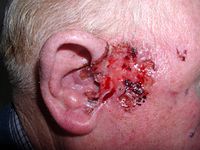
Photo from wikipedia
Importance Patients treated for cutaneous squamous cell carcinoma (SCC) and basal cell carcinoma (BCC), collectively called keratinocyte carcinoma (KC), are at risk for recurrence, metastasis, and additional primary cutaneous malignant… Click to show full abstract
Importance Patients treated for cutaneous squamous cell carcinoma (SCC) and basal cell carcinoma (BCC), collectively called keratinocyte carcinoma (KC), are at risk for recurrence, metastasis, and additional primary cutaneous malignant neoplasms. It is unclear how often patients should be seen for follow-up skin examination after initial treatment of KC. Objective To summarize the recommendations and evaluate the methodological quality of clinical practice guidelines for dermatologic follow-up of patients with BCC and invasive SCC. Evidence Review PubMed, MEDLINE, and Embase were searched for relevant articles published from January 2010 to March 2022. Search terms included guideline, squamous cell carcinoma, and basal cell carcinoma. National or international guidelines containing recommendations for follow-up frequency after a diagnosis of localized cutaneous KC were included. Quality was assessed using the 6 domains of the Appraisal of Guidelines Research and Evaluation II (AGREE II) tool: (1) scope and purpose; (2) stakeholder development; (3) rigor of development; (4) clarity of presentation; (5) applicability; and (6) editorial independence. The Preferred Reporting Items for Systematic Review and Meta-analysis Protocols (PRISMA-P) was used to guide study reporting. Findings Among the 14 guidelines meeting eligibility criteria, there was little consensus on the appropriate follow-up frequency after initial KC treatment. Overall duration of follow-up ranged from a single posttreatment visit to lifelong surveillance. Most guidelines stratified their recommendations by recurrence risk. For low-risk BCC and guidelines that did not stratify by risk, follow-up recommendations ranged from every 6 to 12 months. For high-risk BCC, 1 guideline suggested follow-up every 3 months, while 4 recommended every 6 months. For low-risk SCC, 5 guidelines recommended annual follow-up; 3 guidelines, every 6 months; and 1 guideline, every 3 months. For high-risk SCC, recommendations included a range of follow-up frequencies, spanning every 3 months (n = 5 guidelines), 4 months (n = 1), 6 months (n = 6), or annually (n = 4). One guideline did not use risk stratification and recommended annual screening. The highest scoring AGREE II domain was "scope and purpose," which assessed the guideline's overall objectives, and the lowest scoring was "applicability," which assessed barriers and facilitators to implementation. Conclusions and Relevance The findings of this systemic review highlight variations in follow-up recommendations for patients after initial treatment for KC. Randomized clinical trials are needed to define an optimal follow-up regimen.
Journal Title: JAMA dermatology
Year Published: 2022
Link to full text (if available)
Share on Social Media: Sign Up to like & get
recommendations!